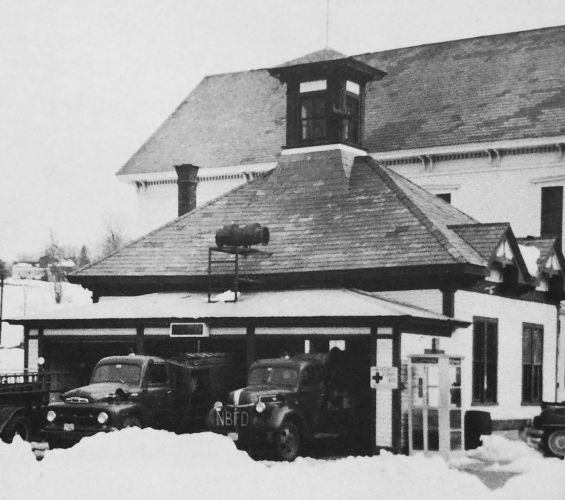New Boston Historical Society
New Boston, New Hampshire

In 1970 the fire station was located in the Old Engine House.
Turn Back the Clock to 1970
by Mary Atai (September 2020)
The fire chief was Ken Barss and there were six fire wards. The town had a fledgling all-volunteer emergency service. The members took first aid courses. There was one ambulance, which ran from 6pm to 6:30am and it was driven by volunteers. S&H Green Stamps were donated by the citizens to buy ambulance equipment.
The fire station was located in the small Victorian building (now housing the Recreation Department) next to the Town Hall. The building barely had enough room for two small fire engines. Luckily, New Boston only had two.
The most controversial topic in town that year was the fate of the high school building, which had graduated its last class in 1965. The question was whether to renovate the old high school into a fire station or to build a new fire station. A 10-member study committee eventually recommended that the building be torn down and the site be used to construct a new firehouse. This plan was carried out and our current station opened in 1973, giving increased fire protection capabilities and breaking many hearts over the loss of the beautiful old school building.
Following the resignation of George O. St. John, John Ballou became the police chief. This was a part-time position. There were seven volunteer police officers. There were no firearms and no police vehicles. Personal cars were used. The depot building became the police station that year and that lasted for 20 years.
The minister at the Community Church was Reverend James Uttley. Easter Sunrise Service was held at Pitman's Orchard, up Valley View Lane. This was long before it became the annual event at Betsy Whitman's home on Cochran Hill.
The Community Church ran a thrift shop then. It was under Carter's Place, a small restaurant in the house at the foot of Old Coach Road, run by Sylvia Carter Chancey, one of the town's great cooks.
Father Paul Fitzgerald was ministering at the 100 Acres Monastery, and the Baptist Church was led by Reverend Walter Poole.
In 1970, the Central School had 222 students through the sixth grade (now about 590). Betsy (Moore) Whitman was the school nurse. That year the schoolchildren traveled to the State House Mall in Concord to view the Apollo spaceship that went to the moon. School hot lunches were $1.65 per week or $.35 per day.
The Whipple Free Library (WFL) was located where the Historical Society is now in the center of the village. It consisted only of the front brick part of the current building, 800 square feet. The chairman of the board of the WFL was Beulah Hayes. She and her husband Reggie gave much to the library for many years, raising money and reading to the children. The "Friends of the Library" group was very active making general improvements. The annual Christmas Wassail was held even then.
The Grange was very active and frequently provided bean suppers as fundraisers. Tickets were $1.50 each and $.75 for children. The Post Office was at Dodge's Store and the postmaster was Gus Andrews. Here everyone could get their food, their mail, and see all their friends at the same time. Homer Dodge ran Dodge's Store. He worked pretty much every day and never took a vacation. There were apparently two wonderful foods at Dodge's, a huge cheese wheel where everyone in town got their cheese, and ground beef that was so delicious, people talk about it still.
Homer extended credit to those who could not pay right then, as did Ella and Leon Daniels at Daniel's Oil and Propane. Their kindness allowed many families to keep going in hard times.
For the young people, there was the 4-H Club. It had the Sewing Girls Group and the Cooking Girls Group, as well as all the work with animals. The 4-H Youth Center completed its very first building and had it ready for the fair in October.
In 1970, the new telephone exchange of 487 came into use, making seven-digit phone numbers required. Prior to that, anyone in town could be reached with a four-digit phone number.
One of the saddest events of 1970 was the burial of Ronald C. Davis, age 21, his body having been returned from Vietnam. He was the first New Boston soldier to die in battle since World War 1. Later, a stretch of River Road was named in his honor and markers were placed at each end. Currently the Historical Society is replacing both of those weathered markers, using the generous donations of the people of the town.
Happily, even after the inevitable changes of time, much has remained the same, and New Boston continues to be a town of warmth, beauty, friendly people, and small-town charm.
Click here to return to the main page for "Behind the Door" articles.
